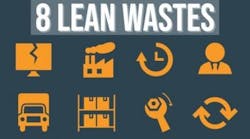By Dean Marsman, VP sales & marketing with Prince Manufacturing
Lean production does not focus exclusively on waste reduction, but waste is minimized or eliminated more as an inevitable byproduct of better production flow. It may seem obvious that waste hurts productivity and profitability, but the importance of reducing waste is often underappreciated. And there are numerous areas of waste that go overlooked.“Waste is anything other than the minimum amount of equipment, materials, parts and working time which is absolutely essential to add value to the product or service,” said Ohno Taiicho, who is known as the father of the Toyota production system.
Lean manufacturing typically focuses on seven key wastes. But let's expand the list to eight, represented by the acronym, DOWNTIME:
Defects: A defective part caused by poor quality inputs, user error, or other problems is costly and easily avoided.
Overproduction: Overproducing irrespective of demand or capacity is wasteful and not considerate of the customer.
Waiting: Bottlenecks occur due to oversupply or undersupply and should be handled by better supply chain management and personnel management.
Not Utilizing Talent: Waste occurs when the skills of the workforce are underutilized or misappropriated. Human talent is a highly valuable and often overlooked commodity.
Transportation: Movement to and from docks and warehouses is an area for potential waste-reduction by better layout and better-aligned process flow.
Inventory Excess: Numerous factors can lead to excessive inventory, which, in a mass-production paradigm, might appear as productivity, yet does not benefit the overall process.
Motion Waste: Even the repetitive motions of employees on the assembly line can diminish productivity and contribute to waste.
Excess Processing: Avoid redundancy and unnecessary steps.
Waste is defined as any step in a process that is not essential to completing that process effectively and successfully. All eight of these wastes contribute to increased time and resources, leading to an inevitable increase in costs. They also act as roadblocks to providing value to your customer.
After waste is eliminated, processes become more streamlined, resulting in higher customer satisfaction.
Want more? Find our library of process-focused features here.
*A version of this piece originally ran here.



